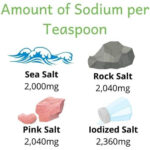Metamorphic rock classification is based on texture and composition, influencing their landscaping applications; learn more at rockscapes.net. Understanding these categories helps homeowners, landscape designers, and material suppliers choose the best stones for gardens and outdoor living spaces. Explore natural stone designs and hardscape materials.
1. What is Metamorphic Rock Classification Based On?
Metamorphic rocks are classified based on their texture (foliated or non-foliated) and mineral composition, which is crucial for landscape design. This classification system helps determine the suitability of different metamorphic rocks for various landscaping applications, from garden pathways to retaining walls.
Metamorphic rocks, formed from pre-existing rocks (igneous, sedimentary, or other metamorphic rocks) subjected to high pressure, heat, or chemical activity, undergo transformations affecting their texture and mineral composition. The resulting rock classification guides professionals in selecting appropriate materials for diverse landscaping projects, ensuring aesthetic appeal and structural integrity.
1.1 Foliated Metamorphic Rocks
Foliated metamorphic rocks exhibit a layered or banded appearance due to the alignment of mineral grains under directed pressure, making them ideal for creating visually striking landscape features. The parallel arrangement of minerals like mica and chlorite gives these rocks a distinct texture that enhances the aesthetic of gardens and outdoor spaces.
- Formation Process: Foliation occurs when pressure is applied unevenly to a rock, causing minerals to align perpendicular to the direction of maximum stress.
- Common Types: Slate, phyllite, schist, and gneiss are typical examples, each with unique characteristics.
- Landscaping Uses: These rocks can be used for pathways, wall cladding, and decorative elements, offering both beauty and functionality.
1.2 Non-Foliated Metamorphic Rocks
Non-foliated metamorphic rocks lack a layered appearance because they form under uniform pressure or from parent rocks with blocky minerals. Their uniform texture and composition make them suitable for applications where a consistent look is desired.
- Formation Process: These rocks form when pressure is equal in all directions or when the parent rock consists of minerals like quartz and calcite that do not easily align.
- Common Types: Marble, quartzite, and hornfels are common examples, each offering unique aesthetic and functional properties.
- Landscaping Uses: Non-foliated rocks are often used for paving, sculptures, and accent pieces, providing durability and a clean, polished appearance.
2. What Are The Different Types of Foliated Metamorphic Rocks?
The different types of foliated metamorphic rocks, including slate, phyllite, schist, and gneiss, offer unique textures and aesthetic qualities suitable for various landscaping designs. Recognizing these variations helps in selecting the best material to achieve a desired landscape appearance, whether it is a rustic garden path or a sophisticated retaining wall.
Each type of foliated rock forms under different metamorphic conditions, resulting in distinctive characteristics that influence their use in landscaping.
2.1 Slate
Slate, formed from the low-grade metamorphism of shale, is characterized by its fine-grained texture and tendency to split into flat sheets, making it an excellent choice for pathways and patios. Its natural durability and resistance to weathering ensure long-lasting beauty in outdoor settings.
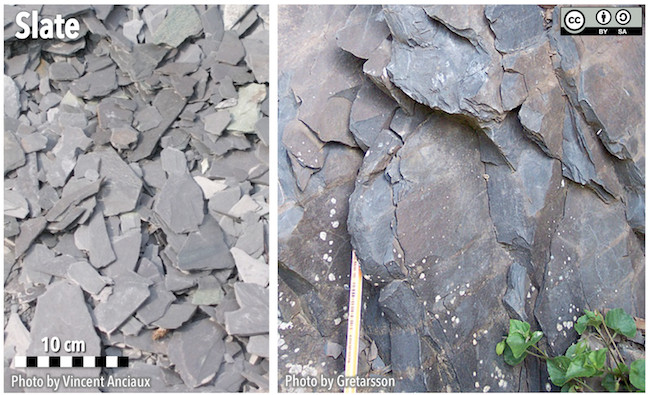 Slate fragments resulting from rock cleavage
Slate fragments resulting from rock cleavage
- Formation: Slate forms under relatively low temperatures and pressures, transforming shale into a denser, more durable rock.
- Characteristics: It has microscopic clay and mica crystals aligned perpendicular to the maximum stress direction, leading to its characteristic slaty cleavage.
- Landscaping Applications: Slate is ideal for creating smooth, even surfaces in pathways and patios, offering a sophisticated and timeless aesthetic.
2.2 Phyllite
Phyllite, similar to slate but formed at higher temperatures, exhibits a satiny sheen on its surface due to the growth of larger mica crystals. This subtle sparkle adds a touch of elegance to landscaping projects, making it suitable for decorative wall cladding and garden accents.
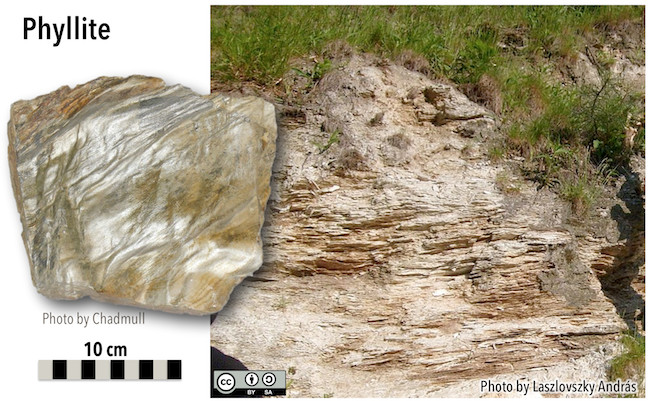 Phyllite hand sample showing a satin texture
Phyllite hand sample showing a satin texture
- Formation: Phyllite forms at higher temperatures than slate, causing the mica crystals to grow larger and produce a distinctive sheen.
- Characteristics: Its cleavage is slightly wavy compared to slate, adding visual interest.
- Landscaping Applications: Phyllite’s unique texture makes it an attractive option for decorative elements and wall cladding, enhancing the overall appeal of outdoor spaces.
2.3 Schist
Schist, formed at higher temperatures and pressures, features visible mica crystals that sparkle in the light, creating a dynamic and eye-catching effect in landscape designs. The presence of other minerals like garnet can add further visual interest, making it suitable for statement pieces and focal points.
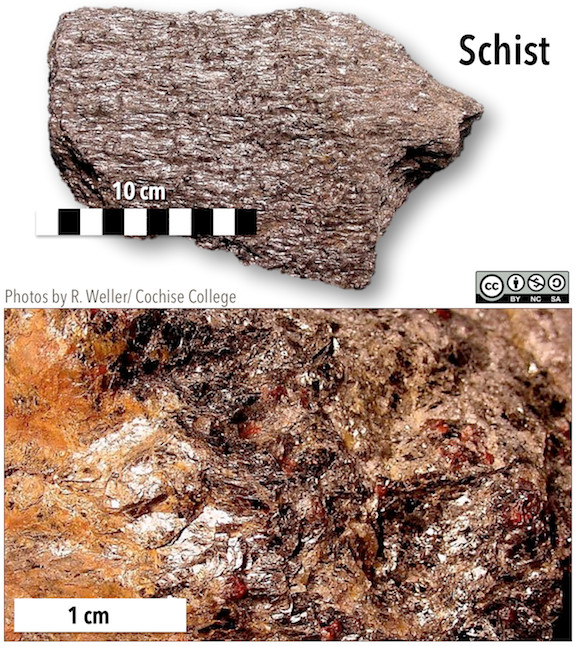 Schist hand sample showing light reflecting off of mica crystals
Schist hand sample showing light reflecting off of mica crystals
- Formation: Schist forms under intense metamorphic conditions, resulting in larger, easily visible mica crystals.
- Characteristics: Individual crystal faces may flash when the sample is turned in the light, giving the rock a sparkling appearance.
- Landscaping Applications: Schist can be used to create striking focal points and decorative accents, adding a touch of luxury to garden designs.
2.4 Gneiss
Gneiss, formed at the highest pressures and temperatures, displays distinct bands of different-colored minerals, making it a popular choice for retaining walls and structural landscaping elements. Its robust nature and unique appearance provide both aesthetic appeal and structural stability.
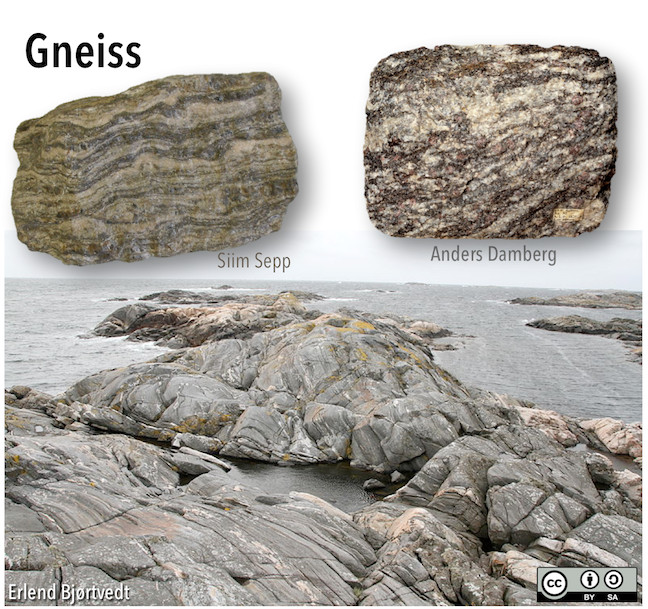 Gneiss hand sample showing color bands
Gneiss hand sample showing color bands
- Formation: Gneiss forms under extreme metamorphic conditions, leading to the separation of minerals into distinct bands.
- Characteristics: The bands are typically composed of light-colored feldspar and quartz alternating with dark-colored amphibole.
- Landscaping Applications: Gneiss is ideal for retaining walls, steps, and other structural elements, providing both strength and a distinctive visual texture.
3. How Does Metamorphic Grade Influence Foliated Rock Types?
Metamorphic grade, the intensity of temperature and pressure during metamorphism, significantly influences the type of foliated rock that forms, affecting its texture and suitability for landscaping. As metamorphic grade increases from low to high, mudrock transitions from slate to phyllite, schist, and finally gneiss, each with distinct properties.
Understanding the relationship between metamorphic grade and rock type allows for informed decisions when selecting materials for landscaping projects.
3.1 Low-Grade Metamorphism
Low-grade metamorphism results in the formation of fine-grained rocks like slate, ideal for applications where a smooth, even surface is desired. The small, tightly packed mineral grains provide durability and a consistent appearance.
- Rock Type: Slate is the primary rock type formed under low-grade conditions.
- Characteristics: Fine-grained texture, excellent cleavage, and a smooth surface.
- Landscaping Uses: Pathways, patios, and roofing are common applications.
3.2 Medium-Grade Metamorphism
Medium-grade metamorphism leads to the formation of rocks like phyllite and schist, which exhibit a slightly coarser texture and a more pronounced sheen, adding visual interest to landscape designs. The larger mineral crystals reflect light, enhancing the aesthetic appeal.
- Rock Types: Phyllite and schist are characteristic of medium-grade metamorphism.
- Characteristics: Visible mica crystals, a satiny or sparkling sheen, and a slightly wavy texture.
- Landscaping Uses: Decorative wall cladding, garden accents, and statement pieces.
3.3 High-Grade Metamorphism
High-grade metamorphism results in the formation of gneiss, a coarse-grained rock with distinct mineral banding, providing a bold and striking appearance for structural landscaping elements. The robust nature of gneiss makes it suitable for load-bearing applications.
- Rock Type: Gneiss is the typical rock formed under high-grade conditions.
- Characteristics: Coarse-grained texture, distinct color banding, and high durability.
- Landscaping Uses: Retaining walls, steps, and other structural elements.
4. What Are The Types of Non-Foliated Metamorphic Rocks Used In Landscaping?
The types of non-foliated metamorphic rocks used in landscaping, including marble, quartzite, and hornfels, offer unique textures and colors that can enhance the aesthetic appeal of outdoor spaces. Their lack of foliation makes them versatile for various design applications.
These rocks are commonly used in landscaping due to their uniform appearance and structural integrity.
4.1 Marble
Marble, metamorphosed limestone, is prized for its smooth texture and elegant appearance, making it a popular choice for sculptures, paving, and decorative elements. Its ability to take a polish and its range of colors add a touch of sophistication to any landscape design.
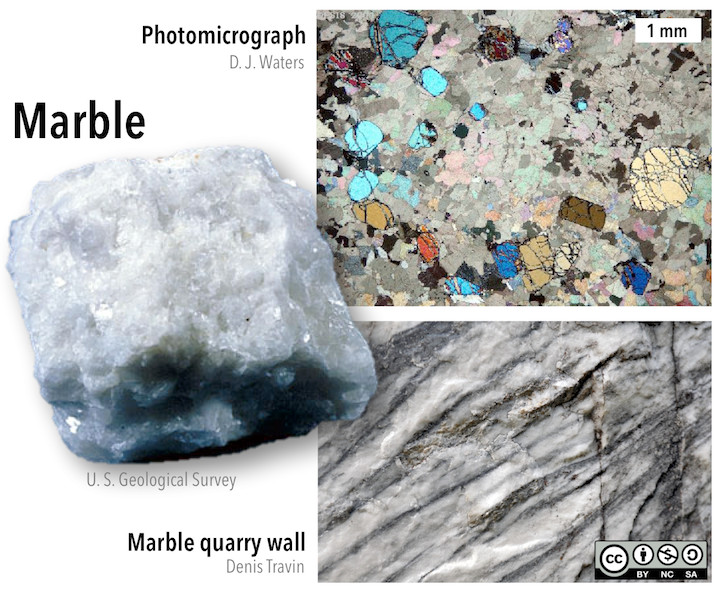 Marble made of pure calcite is white
Marble made of pure calcite is white
- Formation: Marble forms when limestone undergoes metamorphism, causing the calcite crystals to recrystallize.
- Characteristics: Smooth texture, often white or light-colored, and capable of taking a high polish.
- Landscaping Applications: Sculptures, paving, and decorative elements.
4.2 Quartzite
Quartzite, metamorphosed sandstone, is exceptionally hard and durable, making it ideal for pathways, patios, and other high-traffic areas in a landscape. Its resistance to weathering and erosion ensures long-lasting performance.
 Marble made of pure calcite is white
Marble made of pure calcite is white
- Formation: Quartzite forms from the metamorphism of sandstone, welding the quartz grains together with additional silica.
- Characteristics: Extremely hard and durable, typically light-colored, and resistant to weathering.
- Landscaping Applications: Pathways, patios, and retaining walls.
4.3 Hornfels
Hornfels, formed during contact metamorphism of fine-grained rocks, offers a unique, often speckled appearance that adds visual interest to garden borders and accent features. Its random mineral orientation provides a natural, rustic look.
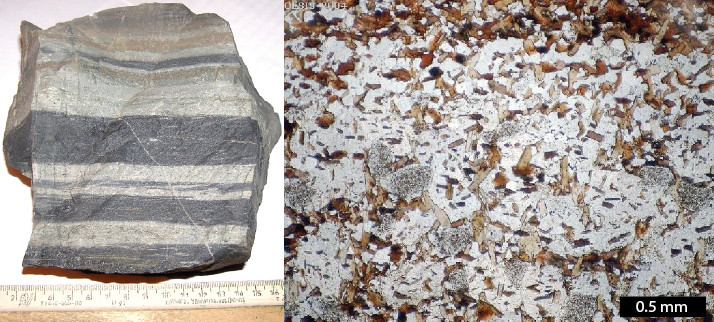 Hornfels from the Novosibirsk region of Russia from a sedimentary protolith
Hornfels from the Novosibirsk region of Russia from a sedimentary protolith
- Formation: Hornfels forms during contact metamorphism, where heat from magma alters the surrounding rock.
- Characteristics: Fine-grained texture, often with a speckled appearance due to the presence of various randomly oriented minerals.
- Landscaping Applications: Garden borders, accent features, and decorative elements.
5. How Does Contact Metamorphism Relate to Non-Foliated Rocks?
Contact metamorphism, which occurs when rocks are heated by nearby magma, often results in the formation of non-foliated rocks due to the uniform pressure conditions. Understanding this process is crucial for selecting appropriate materials for landscaping projects in areas with volcanic activity.
The heat from magma causes the surrounding rocks to recrystallize without the directed pressure needed for foliation.
5.1 Process of Contact Metamorphism
Contact metamorphism involves the alteration of rocks due to the heat from an adjacent magma body, leading to recrystallization and the formation of new minerals. This process typically occurs without significant directed pressure, resulting in non-foliated rocks.
- Heat Source: Magma intrusions provide the heat necessary for metamorphic changes.
- Pressure Conditions: Uniform pressure allows for recrystallization without mineral alignment.
- Resulting Rocks: Marble, quartzite, and hornfels are commonly formed through contact metamorphism.
5.2 Impact on Rock Texture
The lack of directed pressure during contact metamorphism leads to the formation of rocks with a uniform, non-foliated texture, making them suitable for applications where a consistent appearance is desired. The recrystallization process enhances the rock’s durability and aesthetic appeal.
- Uniformity: Non-foliated rocks exhibit a consistent texture without layering.
- Durability: Recrystallization increases the rock’s resistance to weathering and erosion.
- Aesthetic Appeal: Marble, quartzite, and hornfels offer unique colors and textures for landscaping designs.
6. Can the Original Rock Type Affect Metamorphic Rock Classification?
Yes, the original rock type (protolith) significantly affects metamorphic rock classification, influencing the mineral composition and texture of the resulting metamorphic rock. For example, mudrock can transform into slate, phyllite, schist, or gneiss, depending on the metamorphic grade, while limestone becomes marble and sandstone becomes quartzite.
The protolith’s composition dictates the range of metamorphic rocks that can form under different conditions.
6.1 Influence of Protolith Composition
The chemical composition of the protolith determines the minerals that can form during metamorphism, thereby influencing the classification of the resulting rock. Rocks with similar compositions may evolve into different metamorphic rocks depending on the intensity of metamorphism.
- Mudrock Protolith: Can transform into slate, phyllite, schist, or gneiss, depending on metamorphic grade.
- Limestone Protolith: Typically becomes marble, with variations in color and texture based on impurities.
- Sandstone Protolith: Usually becomes quartzite, known for its hardness and durability.
6.2 Examples of Protolith Transformations
Different protoliths undergo distinct transformations during metamorphism, leading to a variety of metamorphic rock types with unique properties and uses in landscaping. Understanding these transformations is essential for selecting appropriate materials for specific design applications.
- Slate from Shale: Shale, a type of mudrock, transforms into slate under low-grade metamorphism, resulting in a fine-grained rock with excellent cleavage.
- Marble from Limestone: Limestone transforms into marble through recrystallization, resulting in a smooth, elegant rock suitable for sculptures and paving.
- Quartzite from Sandstone: Sandstone transforms into quartzite, a highly durable rock ideal for pathways and retaining walls.
7. How Are Schist and Gneiss Further Classified Based on Mineral Content?
Schist and gneiss are further classified based on their mineral content, providing more specific descriptions that help determine their suitability for various landscaping applications. A schist derived from basalt might be rich in chlorite (chlorite schist), while gneiss originating from basalt and dominated by amphibole is called amphibolite.
This detailed classification allows for a precise selection of materials based on aesthetic and functional requirements.
7.1 Naming Conventions Based on Mineralogy
The naming of schist and gneiss often includes the names of prominent minerals present, providing valuable information about their composition and appearance. This naming convention helps landscape designers choose the most appropriate materials for their projects.
- Chlorite Schist: Schist derived from basalt and rich in chlorite.
- Mica Schist: Schist derived from shale and composed primarily of mica.
- Amphibolite: Gneiss that originated as basalt and is dominated by amphibole.
7.2 Examples of Mineral-Based Classification
Specific examples of mineral-based classifications illustrate how the composition of schist and gneiss influences their appearance and use in landscaping. These detailed classifications help in selecting materials that meet specific aesthetic and functional criteria.
- Mica-Garnet Schist: Schist with significant amounts of mica and garnet, offering a sparkling appearance and added visual interest.
- Amphibole Gneiss: Gneiss dominated by amphibole, providing a dark, striking appearance suitable for structural elements.
- Muscovite-Biotite Schist: Schist containing both muscovite and biotite mica, offering a blend of light and dark tones for a dynamic aesthetic.
8. What Role Does Rockscapes.Net Play in Metamorphic Rock Selection for Landscaping?
Rockscapes.net plays a crucial role in metamorphic rock selection for landscaping by providing comprehensive information, design inspiration, and expert guidance to homeowners, landscape designers, and material suppliers. By offering detailed insights into the properties and applications of various metamorphic rocks, Rockscapes.net empowers users to make informed decisions that enhance the beauty and functionality of their outdoor spaces.
Rockscapes.net helps customers find the perfect stone for their unique landscaping needs.
8.1 Providing Detailed Information
Rockscapes.net offers extensive information on different types of metamorphic rocks, including their formation, characteristics, and ideal applications in landscaping. This resource helps users understand the unique properties of each rock type and how they can be used to achieve specific design goals.
- Rock Profiles: Detailed descriptions of slate, phyllite, schist, gneiss, marble, quartzite, and hornfels.
- Formation Details: Information on how each rock type forms under different metamorphic conditions.
- Application Guides: Suggestions for using different metamorphic rocks in pathways, walls, sculptures, and other landscaping elements.
8.2 Offering Design Inspiration
Rockscapes.net showcases a wide range of landscape designs featuring metamorphic rocks, providing inspiration for homeowners and landscape designers looking to create stunning outdoor spaces. The site’s gallery of images and case studies demonstrates the versatility and aesthetic appeal of metamorphic rocks in various settings.
- Image Galleries: Collections of inspiring landscape designs featuring different metamorphic rocks.
- Case Studies: Real-world examples of how metamorphic rocks have been used in successful landscaping projects.
- Design Tips: Expert advice on incorporating metamorphic rocks into gardens, patios, and other outdoor spaces.
8.3 Providing Expert Guidance
Rockscapes.net connects users with experts in the field of landscape design and stone supply, offering personalized guidance and support for selecting and implementing metamorphic rocks in their projects. This expert assistance ensures that users can make informed decisions and achieve their desired outcomes.
- Expert Consultations: Opportunities to connect with landscape designers and stone suppliers for personalized advice.
- Technical Support: Assistance with installation techniques, maintenance tips, and other technical aspects of using metamorphic rocks.
- Supplier Directory: A comprehensive directory of trusted stone suppliers in the USA, making it easy to source high-quality materials.
9. What Are The Key Considerations When Choosing Metamorphic Rocks for Landscaping?
When choosing metamorphic rocks for landscaping, key considerations include the rock’s durability, aesthetic appeal, maintenance requirements, and suitability for the intended application, ensuring a long-lasting and visually pleasing result. Evaluating these factors helps homeowners and designers select the best materials for their specific needs.
Careful planning ensures that the chosen rocks enhance the landscape’s beauty and functionality.
9.1 Durability and Weather Resistance
Durability and weather resistance are critical factors to consider, especially in regions with harsh climates. Metamorphic rocks like quartzite and gneiss are known for their ability to withstand extreme temperatures, moisture, and physical wear, making them ideal for pathways, retaining walls, and other high-exposure applications.
- Climate Considerations: Choosing rocks that can withstand the local climate conditions, such as freeze-thaw cycles or intense sunlight.
- Traffic Levels: Selecting durable rocks for high-traffic areas to prevent wear and damage.
- Exposure to Elements: Ensuring that the chosen rocks can resist weathering, erosion, and staining.
9.2 Aesthetic Appeal and Design Compatibility
The aesthetic appeal of metamorphic rocks and their compatibility with the overall landscape design are essential for creating visually stunning outdoor spaces. Considering the color, texture, and pattern of the rocks ensures that they complement the surrounding vegetation, structures, and other design elements.
- Color Palette: Coordinating the color of the rocks with the overall color scheme of the landscape.
- Texture and Pattern: Selecting rocks with textures and patterns that enhance the visual interest of the design.
- Design Style: Choosing rocks that align with the desired design style, whether it’s rustic, modern, or traditional.
9.3 Maintenance Requirements
The maintenance requirements of metamorphic rocks should be considered to ensure that the landscape remains beautiful and functional over time. Some rocks may require regular cleaning, sealing, or other maintenance to prevent staining, fading, or other forms of degradation.
- Cleaning Needs: Determining how often the rocks will need to be cleaned to maintain their appearance.
- Sealing Requirements: Assessing whether the rocks need to be sealed to protect them from staining and moisture damage.
- Long-Term Care: Understanding the long-term maintenance requirements to ensure the rocks retain their beauty and durability.
9.4 Application Suitability
The suitability of metamorphic rocks for the intended application is a critical consideration, ensuring that they can withstand the expected loads, stresses, and environmental conditions. Different rocks are better suited for different applications, such as paving, wall construction, or decorative accents.
- Load-Bearing Capacity: Selecting rocks that can support the expected loads for paving and wall construction.
- Stability and Support: Ensuring that the rocks provide adequate stability and support for retaining walls and other structural elements.
- Design Integration: Choosing rocks that can be easily integrated into the overall landscape design for a cohesive and functional result.
10. What Are Some Emerging Trends in Metamorphic Rock Landscaping in the USA?
Emerging trends in metamorphic rock landscaping in the USA include the increased use of locally sourced stones, sustainable landscaping practices, and innovative design applications, reflecting a growing emphasis on environmental responsibility and creative expression. Staying informed about these trends can help homeowners and designers create cutting-edge outdoor spaces.
Embracing these trends can lead to more beautiful, sustainable, and functional landscapes.
10.1 Locally Sourced Stones
The increased use of locally sourced metamorphic rocks supports regional economies, reduces transportation costs and carbon emissions, and ensures that the materials are well-suited to the local climate and environment. This trend reflects a growing awareness of the environmental and economic benefits of sourcing materials locally.
- Reduced Environmental Impact: Minimizing transportation distances to lower carbon emissions.
- Support for Local Economies: Investing in regional stone suppliers and artisans.
- Climate Compatibility: Ensuring that the chosen rocks are well-suited to the local climate conditions.
10.2 Sustainable Landscaping Practices
Sustainable landscaping practices, such as using permeable paving materials and incorporating native plants, are becoming increasingly popular in the USA. Metamorphic rocks can play a key role in these practices by providing durable, natural surfaces that reduce runoff, support plant growth, and enhance biodiversity.
- Permeable Paving: Using metamorphic rocks to create permeable surfaces that allow water to filter into the ground.
- Native Plant Integration: Combining metamorphic rocks with native plants to create ecologically beneficial landscapes.
- Water Conservation: Designing landscapes that minimize water use through efficient irrigation and drought-tolerant plantings.
10.3 Innovative Design Applications
Innovative design applications of metamorphic rocks, such as creating vertical gardens, sculptural installations, and interactive water features, are pushing the boundaries of traditional landscaping. These creative uses showcase the versatility and aesthetic potential of metamorphic rocks in transforming outdoor spaces.
- Vertical Gardens: Using metamorphic rocks to create stunning vertical gardens that add texture and visual interest to walls and fences.
- Sculptural Installations: Incorporating metamorphic rocks into sculptural installations that serve as focal points in the landscape.
- Interactive Water Features: Designing water features that incorporate metamorphic rocks, creating dynamic and engaging outdoor spaces.
Ready to transform your outdoor space with the timeless beauty of metamorphic rocks? Visit rockscapes.net today for inspiration, expert advice, and the highest quality stone selection in the USA. Let us help you create the landscape of your dreams! You can visit us at 1151 S Forest Ave, Tempe, AZ 85281, United States or call us at +1 (480) 965-9011.
FAQ: How Are Metamorphic Rocks Classified?
1. What are the two main classifications of metamorphic rocks?
Metamorphic rocks are primarily classified as either foliated or non-foliated based on their texture. Foliated rocks have a layered or banded appearance due to mineral alignment, while non-foliated rocks lack this layered texture.
2. What causes foliation in metamorphic rocks?
Foliation is caused by directed pressure during metamorphism, which forces mineral grains to align perpendicular to the direction of maximum stress. This alignment creates a layered or banded appearance.
3. What are some examples of foliated metamorphic rocks?
Examples of foliated metamorphic rocks include slate, phyllite, schist, and gneiss. These rocks are often used in landscaping for their unique textures and visual appeal.
4. How does metamorphic grade affect the type of foliated rock that forms?
Metamorphic grade, or the intensity of temperature and pressure, influences the type of foliated rock that forms. Low-grade metamorphism results in slate, medium-grade in phyllite and schist, and high-grade in gneiss.
5. What are some examples of non-foliated metamorphic rocks?
Examples of non-foliated metamorphic rocks include marble, quartzite, and hornfels. These rocks are often used in landscaping for their uniform appearance and durability.
6. What is contact metamorphism, and how does it relate to non-foliated rocks?
Contact metamorphism occurs when rocks are heated by nearby magma. This process often results in the formation of non-foliated rocks because the pressure is uniform, not directed.
7. How does the original rock type (protolith) affect metamorphic rock classification?
The original rock type, or protolith, significantly affects the mineral composition and texture of the resulting metamorphic rock. For example, mudrock can transform into slate, phyllite, schist, or gneiss, depending on the metamorphic grade.
8. How are schist and gneiss further classified based on mineral content?
Schist and gneiss can be further classified based on their mineral content. For example, a schist derived from basalt might be rich in chlorite (chlorite schist), while gneiss originating from basalt and dominated by amphibole is called amphibolite.
9. What are some key considerations when choosing metamorphic rocks for landscaping?
Key considerations include the rock’s durability, aesthetic appeal, maintenance requirements, and suitability for the intended application. Evaluating these factors helps ensure a long-lasting and visually pleasing result.
10. What are some emerging trends in metamorphic rock landscaping in the USA?
Emerging trends include the increased use of locally sourced stones, sustainable landscaping practices, and innovative design applications. These trends reflect a growing emphasis on environmental responsibility and creative expression.
